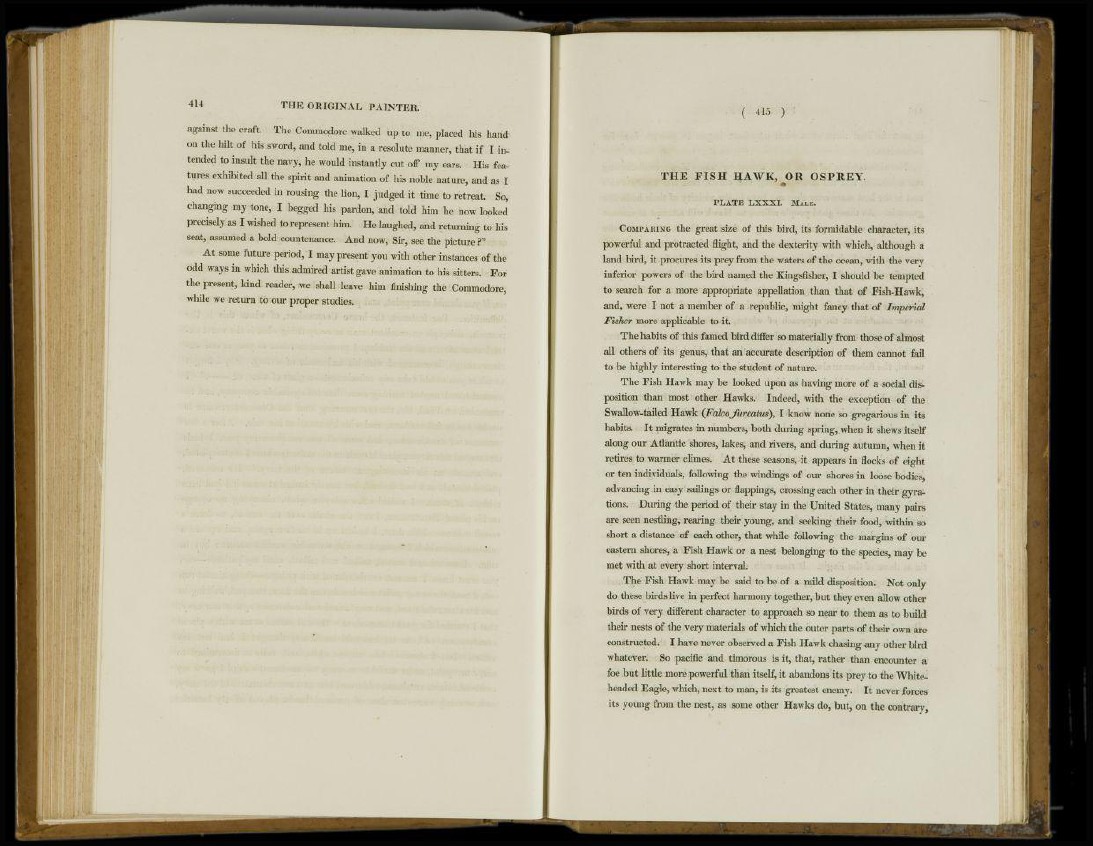
414 THE ORIGINAL PAINTER.
against the craft. The Commodore walked up to me, placed his hand
on the hilt of his sword, and told me, in a resolute manner, that if I intended
to insult the navy, he would instantly cut off my ears. His features
exhibited all the spirit and animation of his noble nature, and as I
had now succeeded in rousing the lion, I judged it time to retreat. So,
changing my tone, I begged his pardon, and told him he now looked
precisely as I wished to represent him. He laughed, and returning to his
seat, assumed a bold countenance. And now, Sir, see the picture ?"
At some future period, I may present you with other instances of the
odd ways in which this admired artist gave animation to his sitters. For
the present, kind reader, we shall leave him finishing the Commodore,
while we return to our proper studies.
THE F I S H HAWK, OR OSPREY.
• • •
P L A T E L X X X I . MALE.
COMPARING the great size of this bird, its formidable character, its
powerful and protracted flight, and the dexterity with which, although a
land bird, it procures its prey from the waters of the ocean, with the very
inferior powers of the bird named the Kingsfisher, I should be tempted
to search for a more appropriate appellation than that of Fish-Hawk,
and, were I not a member of a republic, might fancy that of Imperial
Fisher more applicable to it.
The habits of this famed bird differ so materially from those of almost
all others of its genus, that an accurate description of them cannot fail
to be highly interesting to the student of nature.
The Fish Hawk may be looked upon as having more of a social disposition
than most other Hawks. Indeed, with the exception of the
Swallow-tailed Hawk (FalcoJurcatus), I know none so gregarious in its
habits. It migrates in numbers, both during spring, when it shews itself
along our Atlantic shores, lakes, and rivers, and during autumn, when it
retires to warmer climes. At these seasons, it appears in flocks of eight
or ten individuals, following the windings of our shores in loose bodies,
advancing in easy sailings or flappings, crossing each other in their gyrations.
During the period of their stay in the United States, many pairs
are seen nestling, rearing their young, and seeking their food, within so
short a distance of each other, that while following the margins of our
eastern shores, a Fish Hawk or a nest belonging to the species, may be
met with at every short interval.
The Fish Hawk may be said to be of a mild disposition. Not only
do these birds live in perfect harmony together, but they even allow other
birds of very different character to approach so near to them as to build
their nests of the very materials of which the outer parts of their own are
constructed. I have never observed a Fish Hawk chasing any other bird
whatever. So pacific and timorous is it, that, rather than encounter a
foe but little more powerful than itself, it abandons its prey to the Whiteheaded
Eagle, which, next to man, is its greatest enemy. It never forces
its young from the nest, as some other Hawks do, but, on the contrary,